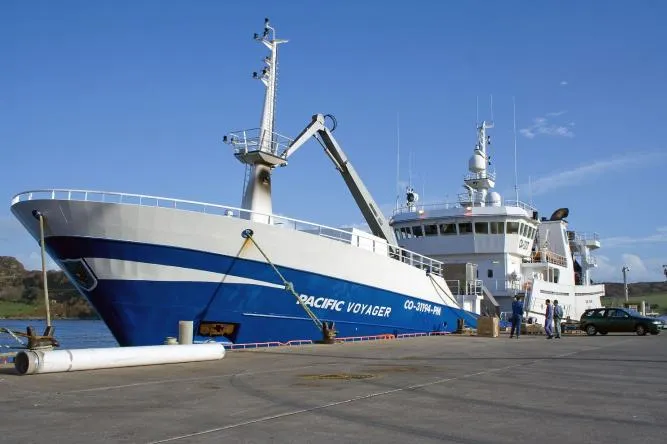
Pacific Andes profit up 7.4% to HK$1.09bn
The fishing company achieved sustained organic growth momentum across all operations while capturing expansion opportunities.
Leading international frozen seafood supplier Pacific Andes International Holdings Limited is released its annual results for the year ended 28 September 2010 (“FY2010”).
Gross profit scored a solid 10.2% growth to HK$2,315 million (US$297 million) versus a 1.8% increase in revenue to HK$11.5 billion (US$1,471 million) thanks to the strong foundation built throughout the years. Enhanced efficiency and disciplined cost control, coupled with the continued growth of higher-margin fishing business has fueled the Group’s organic growth. EBITDA saw an increase of 13.2% to HK$2,256 million (US$289 million) while net profit rose 7.4% to HK$1,091 million (US$140 million). Basic earnings per share were HK 16.3 cents (FY2009: HK 22.3 cents).
The Board of Directors has recommended a final dividend of HK4.6 cents per share (six-month period ended 28 September 2009: HK 1.7 cents), representing payout ratio of 33.33% of the consolidated recurring net profits. Shareholders are provided with an option to receive the final dividend in the form of Scrip Shares in lieu of cash, according to a Pacific Andes report.
The fishing division, which operates through its Singapore-listed subsidiary China Fishery, recorded a revenue increase of 12.3% to HK$4,204 million (US$539 million), accounting for 36.6% of the Group’s total revenue. This was mainly attributable to higher fishmeal selling prices, higher sales volume in the North Pacific operations and the first full year contribution from the South Pacific operations.
Economies of scale and operating efficiencies are the key drivers of growth of the fishing division. By strategically closing two fishmeal plants and decreasing the number of operating vessels in Peru, cost of sales and vessel-operating expenses are largely reduced while fishing its entire quota share. Acquisition of two Peruvian fishing companies in May 2010 has also increased the Group’s fishing quota share to 6.05%, which is equivalent to a sharp rise of the division’s future fishmeal and fish oil production by approximately 20%.
In addition, the division has enhanced operating efficiencies of its North Pacific fishing fleet by streamlining the number of vessels. Meanwhile, the Group’s South Pacific operating model that successfully enabled the South Pacific fleet to operate more efficiently has paid off through fewer crew and lower energy consumption.
The frozen fish SCM division, which operates through its Singapore listed subsidiary Pacific Andes Resources Development Limited (“PARD”), recorded a 18.4% drop in revenue to HK$3,229 million (US$414 million), accounted for 28.1% of the Group’s total revenue. This was mainly due to the lower selling price of the Group’s major fish products arising from the increased total supply from the North Pacific, and a temporary shipment delay in the fourth quarter of the financial year.
During the year, the division acquired two additional transportation vessels, each able to carry 7,500 tonnes of cargo per voyage. With the deployment of additional vessels in FY2011, the division will be able to lower per unit cost of transportation and reduce reliance on third party chartered vessels, thus enhancing delivery efficiency.
The processing and distribution division recorded a 13.6% increase in revenue to HK$4,005 million (US$513 million), or 34.9% of the Group’s total revenue, mainly attributable to higher sales volume of frozen fish fillet to the European markets.
The division launched a new ERP and supply chain management system across its operations in the Hongdao Processing Complex, providing a reliable and highly scalable system to support its growing business.
Looking ahead, the fishing division will continue to explore acquisition and consolidation opportunities in new geographical markets and existing markets while enhancing operating efficiency of the fishing fleet at the same time. In respect of the frozen fish SCM division, PARD signed a sale and purchase agreement to acquire 19.76% stake of ASX-Listed vertically integrated salmon grower Tassal Group Limited in December 2010. This investment marks the division’s first investment into the aquaculture industry. The frozen fish SCM division will continue to look for opportunities to invest in high-quality resources that are limited in supply, yet enjoy a strong demand.
In respect of the processing and distribution division, the Group will continue to optimise its processing capacity in the PRC and to further enhance its capabilities of offering value-added seafood products through product innovation. Moreover, leveraging on the Group’s experience and understanding of the Chinese domestic market, plus its state-of-the-art processing facilities in Qingdao, the Group is planning to market its own household fish brand targeting the burgeoning Chinese market in the years to come.
Mr. Ng Joo Siang, Vice-Chairman and Managing Director of Pacific Andes, said, “During the year, Pacific Andes took full advantage of the strong foundations we have systematically built for the Group in the past. With our proven model in aggressively pursuing acquisition opportunities and organic growth, 2010 has also been an active year for Pacific Andes. We have successfully positioned ourselves to harnessing new opportunities and delivering satisfactory results in accordance with our growth plans.”
“Our future is filled with opportunities. Opportunistic acquisitions and an ongoing focus on efficiency enhancement and operational excellence will continue to play a significant role in Pacific Andes’s strategy. Capitalizing on our sound business foundation, our leading position in the industry and capacity in products innovation as well as sales and distribution network that stretch across the globe, we are well-placed to exploit existing opportunities for growth and to further extend our value chain. In order to support our ongoing growth initiatives, we will strive to further solidify the financial foundation of the Group. ”Mr. Ng concluded.








![Cross Domain [Manu + SBR + ABF + ABR + FMCG + HBR + ]](https://cmg-qa.s3.ap-southeast-1.amazonaws.com/s3fs-public/styles/exclusive_featured_article/public/2025-01/earth-3537401_1920_4.jpg.webp?itok=WaRpTJwE)









 Advertise
Advertise


